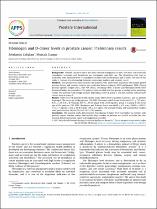| dc.contributor.author | Çalışkan, Selahattin | |
| dc.contributor.author | Sungur, Mustafa | |
| dc.date.accessioned | 2019-05-13T09:07:51Z | |
| dc.date.available | 2019-05-13T09:07:51Z | |
| dc.date.issued | 2017 | |
| dc.identifier.citation | Çalışkan, S., Sungur, M. (2017). Fibrinogen and D-dimer levels in prostate cancer: Preliminary results. Prostate International, 5(3), 110-112. | en_US |
| dc.identifier.issn | 2287-8882 | |
| dc.identifier.uri | https://doi.org/10.1016/j.prnil.2017.05.001 | |
| dc.identifier.uri | https://hdl.handle.net/11491/1888 | |
| dc.description.abstract | Background Prostate cancer is one of the most common malignancy in men. The main risk factors for coagulation activation and thrombosis are malignancy and older age. The thrombosis risk may be associated with increased level of coagulation markers such as fibrinogen and D-dimer. The aim of this study is evaluate the relationship between coagulation markers and prostate cancer. Methods This prospective study includes the patients who underwent transrectal ultrasound guided prostate biopsy and prostate surgery was performed between January 2015 and January 2016. Plasma prostate specific antigen (PSA), free PSA (fPSA), percentage fPSA, D-dimer and fibrinogen levels were measured before the procedures. The patients were divided into two groups according to the pathology results. The patients with benign prostate hyperplasia were in group 1 and the patients with prostate cancer were in group 2. Results There were 76 patients in the current study. There were 53 patients in group 1 and 23 patients in group 2. The mean age of the patients, PSA, fPSA, fibrinogen and D-dimer levels was 65.33 ± 7.47 years, 8.21 ± 4.59, 1.41 ± 0.74 ng/ml, 309.75 ± 80.46 mg/dl, 0.42 ± 0.39 ug/ml in group 1. In group 2; the mean age of the patients, PSA, fPSA, fibrinogen and D-dimer levels was 66.08 ± 6.7 years, 145.69 ± 509.35, 7.32 ± 15 ng/ml, 312.16 ± 69.48 mg/dl, 1.09 ± 2.11 ug/ml. The prostate biopsy and transurethral surgery were performed in 64(%84.21) and 12(%15.79) patients. Conclusion The present study demonstrated that plasma D-dimer level was higher in patients with prostate cancer. Further studies that include large number of patients are needed to define the relationship between prostate cancer and coagulation disorder. © 2017 | en_US |
| dc.language.iso | eng | |
| dc.publisher | Elsevier B.V. | en_US |
| dc.relation.isversionof | 10.1016/j.prnil.2017.05.001 | en_US |
| dc.rights | info:eu-repo/semantics/openAccess | en_US |
| dc.rights | Attribution-NonCommercial-NoDerivatives 4.0 International (CC BY-NC-ND 4.0) | * |
| dc.rights.uri | https://creativecommons.org/licenses/by-nc-nd/4.0/ | * |
| dc.subject | D-dimer | en_US |
| dc.subject | Hypercoagulability | en_US |
| dc.subject | Prostate Cancer | en_US |
| dc.title | Fibrinogen and D-dimer levels in prostate cancer: Preliminary results | en_US |
| dc.type | article | en_US |
| dc.relation.journal | Prostate International | en_US |
| dc.department | Hitit Üniversitesi, Tıp Fakültesi, Cerrahi Tıp Bilimleri Bölümü | en_US |
| dc.identifier.volume | 5 | en_US |
| dc.identifier.issue | 3 | en_US |
| dc.identifier.startpage | 110 | en_US |
| dc.identifier.endpage | 112 | en_US |
| dc.relation.publicationcategory | Makale - Uluslararası Hakemli Dergi - Kurum Öğretim Elemanı | en_US |



















